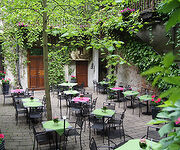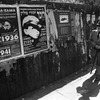In Search of Lost Chocolate
Tucked away in a corner of Cracow's main market square is a little chocolate shop, owned by a certain venerable old Polish brand. With its polished wooden counter, gleaming brass features and flamboyant, faded antique mirrors, it is not without a touch of Dickensian charm. And then of course there is the smell - that rich all enveloping waft that hits you as soon as you open the door - enough to transport you straight back to the world of Charlie and the Chocolate Factory.
Inside this temple of sweetness all is chocolate. The goodies themselves are arranged in transparent cabinets along the marble-topped counter - dozens of varieties jostle for your attention. Some are wrapped in gleaming coloured foils, whilst others are 'au naturel' as the Frogs would say - a tasting session seems the only reasonable course of action. Behind the counter a pretty girl in a pre-war type livery smiles and asks which variety will be the order of the day....
One can understand that when faced with such an assault on the senses, one might be inspired to indulge oneself a little.
'What a marvelous Christmas present' I thought, on discovering the place a few years ago, and I decided to take a box home so that I might introduce the family to the glorious galaxy of Polish chocolate. Without further ado, I asked the charming lady to rustle up a mixed assortment - they all looked equally good of course.
Then, in mid December, I set off on the journey home across wild mountains and over stormy seas. After many adventures, (including several dicey encounters with tentacled sea monsters) I managed to get the present home - unsquashed - and on Christmas Day I revealed the great prize.
Beaming smiles greeted this treasure, and our dogs, Julius and Otto, looked equally inspired.
However, all did not bode well for the venerable choccies. And despite all English attempts at politeness, it quickly emerged that the sweets were not the triumphant success that had been hoped for.
I decided to try one myself, which, perhaps rather foolishly, I had not done whilst back in Poland. I took off the wrapper and surveyed the thing. It was quite a large chocolate, dark, and shaped a bit like a kidney bean. It would stretch to about three mouthfuls perhaps.
On biting into it everything seemed fine at first. But then a sandy texture began to offset the soft exterior. It was rich, very rich. Very, very rich in fact. I polished it off like a gallant knight, and, still keen to give the collection the benefit of the doubt, soldiered on and tried a different variety - perhaps this one would be the Holy Grail of Polish chocolates.
But alas the second chocolate was just as sickly and sandy as the first. Looks of pained sympathy indicated that my own reaction was far from unique. There was no getting away from it - these chocolates were beyond redemption. And barely had I finished the second one when a distinct sense of ill-being kicked in.... I was venturing into the world of the sick. A third chocolate was now out of the question. We all agreed that the Gods had not smiled on these chocolates, rather, the sweets appeared to be a trick of some mischievous devil.
My father devised the brilliant solution of giving the remaining chocolates (of which there were several dozen) to his colleagues at work. Allegedly they were absolutely delighted with them, and they were happily chomping away throughout January. ( I chose to believe this line, as I wanted there to be a happy ending to the story.)
Nevertheless, subconsciously, and with heavy heart, I decided never to try Polish chocolate ever again.
It is at this stage in the story, dear readers, that a rather strange development must be acknowledged. For although over two years were to pass (during which I stayed well clear of anything that combined Poland and chocolate) a road to Damascus type conversion was looming on the horizon.
One day on a journey to the Tatra mountains, I was offered a piece of chocolate by a very noble Polish lady, and I felt it rude to decline. The results were a revelation. A few weeks later, a second Polish lady, (equally noble) offered me another chocolate (this one from the brand of the Christmas present). It was delicious. Repeated experiments over the next few months continued to draw superlative results.
After a good deal of conscientious studying, it seemed more than safe to try and spread the good word about Polish chocolate. And the brand that had rustled up the sickly assortment (perhaps the shop assistant had unloaded the most unpopular varieties onto the silly foreigner as an amusing and very effective joke?) had some of the most delicious varieties of all.
So, in an effort to fight the propaganda, we have compiled a list of some tried and tested chocolates. Armed with this insider's guide, you may well find yourself on the brink of a deep and meaningful relationship - an affair that touches your soul to the very core.
However, before we divulge the secrets of this weird and wonderful world, we have enclosed a profoundly learned history of Polish experiments with the venerable bean.
Polish Chocolate: A Little History
Chocolate first came to Europe in the sixteenth century, although the first chocolate parlour itself did not open until 1657, when a Frenchman opened an establishment in London. Chocolate was largely an aristocratic pleasure in those days, and it was consumed as a hot drink. ''None but the rich and noble could afford to drink chocolate as it was literally drinking money,' noted one contemporary Spanish writer. 'Cocoa passed currency as money among all nations; thus a rabbit in Nicaragua sold for 10 cocoa nibs, and 100 of these seeds could buy a tolerably good slave."
Poles encountered the drink on their travels in France, where the drink was very much de rigueur. One Polish gentleman who was renowned for his sweet tooth was the ill-starred King Stanislas Poniatowski (r.1764-95), who was indeed the last king of Poland. An enlightened man, he was also the greatest connoisseur of Poland's monarchs, with a penchant for art, architecture and attractive ladies. He used to carry around a little silver box in his waistcoat pocket so that he always had a sweet to hand. Keen to please his majesty, the venerable Jagiellonian University of Cracow had a special chocolate concocted for a dinner that they held in his honour in 1782. By chance a piece of this chocolate was kept by the University, and it can still be found in an eighteenth century cabinet in the Collegium Maius Musuem in Cracow. What would happen if one took a bite of it today bears little thinking about - one would either drop dead or turn into a frog one would imagine.
Two of the most distinguished Polish chocolate brands are Wedel (f.1851) and Wawel (f.1898, originally Piasecki). The story of the former provides a telling echo of Poland's twentieth century experience. Prior to the war, Wedel was a flourishing private company with shops in London and Paris. The war dealt a harsh blow, and this was followed by a complete reorganization of the business with the advent of communist rule. All Polish businesses that employed more than 50 staff were nationalized in 1948, and the Wedel plant itself was renamed '22 Lipca' (22nd July) after the Communist 'Independence Day'.
The quality of the chocolate was not always up to pre-war standards. One thing that Poles have not forgotten from the pre-1989 world is the phenomenon of 'wyrob czekoladopodobny' ('chocolatesimilar product'). The mere mention of the words will have Poles screwing up their faces in disgust as if you have mentioned an explosion of the sewage works. Nevertheless, the sheer grotesqueness of the stuff inspires plenty of laughs.
After the democratic changes of 1989, the inevitable battles of privatization and globalization began. Wedel was originally bought by Pepsi, who soon bailed out to CadburySchweppes in 1998. Wawel managed to come through the storm and it remains under Polish ownership.
Allthesame, both companies are flourishing, and they have managed to revive traditional pre-war recipes as well as introduce new ones to the market. With the days of 'czekoladopodobny' fading into the distance, the Poles' sweet tooth is becoming increasingly evident. Indeed, whilst it is usually the Austrians who are noted for their softspot for cakes, creams and chocolates, the Poles can certainly give their neighbours a run for their money in this respect. In 1997 analysts noted that Poland was the fastest growing market for chocolate in Europe, with consumption increasing by 17% annually - the future of Polish chocolate looks bright.
Polish Chocolate: An Insider's Guide
Below are some tried and tested classics that are well worth investigating. Like our waist-sizes, the list will be added to on further investigation. (One word of warning - if you're inspired to buy a mixed assortment, try before you buy, just in case you end up with juniper berry delight, or some such monstrosity)
WAWEL (founded 1898 as Piasecki):
Jagiellonska 'Czekolada Mleczna' (Milk Chocolate): The classic bar. Named after the great Jagiellon dynasty who reigned in Poland during the Middle Ages. Quite reasonable, but nothing to write a sonnet about.
Jacek: Small bar with dark chocolate and a fondant orange centre. Absolutely delicious if you like any of the aforementioned flavours.
Maciek: Similar style bar to the former that comes in several varieties, toffee etc. Particularly recommended is the 'Advokat' type, which is milk chocolate with a caramel-ish centre with, of course, advocat. Highly congenial.
Malaga: Bite-sized dark chocolate with a caramel centre and a hint of plum. Excellent.
GOPLANA (founded 1979):
Pastylki Mietowe: Delicious chocolates with a fondant mint centre (similar to the English Bendicks variety).
WEDEL (founded 1851):
'Czekolada Mleczna' (Milk Chocolate) - The classic Wedel bar. Delicious (although suspiciously reminiscent of a certain Cadbury classic.....!)
z Orzechami - The same with nuts, very tasty. (green wrapper)
Not be confused with 'Orzechowa' which has a hazelnut fondant centre - perhaps even more delicious, and possibly the best of them all. (Yellow wrapper)
There is also a surprisingly good one with coconuts ( orzech kokosowy)
Barylki: A box of miniature 'barrels' with liqueur fillings. Fine.
Ptasie Mleczko - 'Milk birds'. Bite-sized chocolates with a blancmange type filling. Some Poles (and expats) go crazy for these. Worth a try, although in this spoilsport writer's eyes they are unremarkable. (Sorry Mr Ptasie Mleczko)
Comments
Just tried barylki chocolate barrels as a polish employer brought them as a gift for my friends mum but she wasn't brave enough to try them the cacoa choix r the best flavour mmmmm thanks Poland!
Reply
 Kawaleria Szarza Smaku
Kawaleria Szarza Smaku
 Europejska
Europejska
 Krakow Pinball Museum
Krakow Pinball Museum






